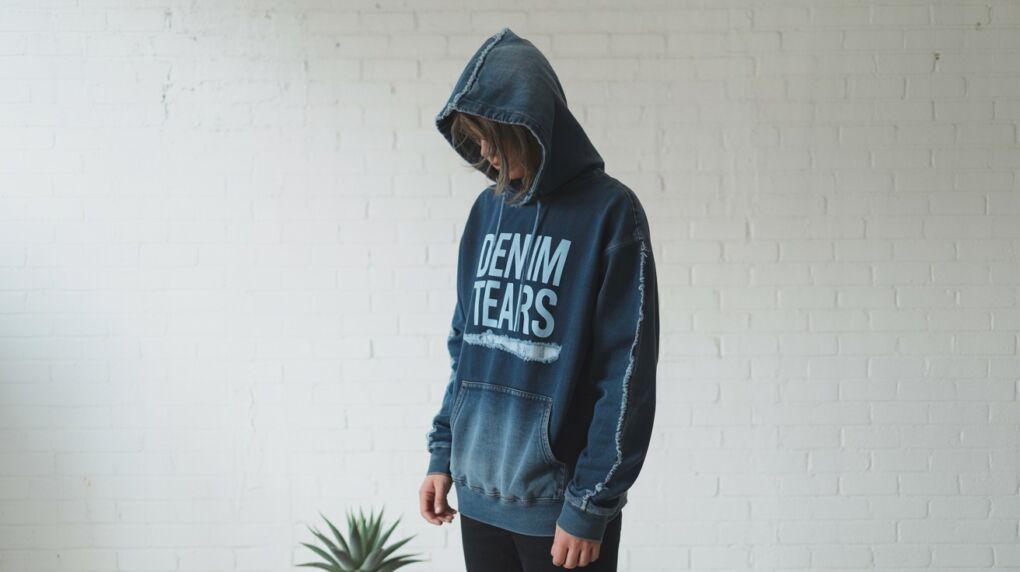In a world flooded with fast fashion and fleeting trends, Denim Tears stands as a bold, cultural force—one that’s not only redefining streetwear but effective vital fictions of identity, tradition, and resistance. As we step into 2025, choosing Denim Tears isn’t almost upgrading your wardrobe; it’s about aligning with a deeper message. Here’s the reason Denim Tears should be your go-to fashion label this year and further.

What Are Denim Tears?
Founded by Tremaine Emory in 2019, Denim Tears is far in addition a fashion brand—it’s a cultural collection stitched into denim, understand, and narrative design. Emory, a prominent creative in the fashion experience and former Creative Director of Supreme, started the brand as a response to the silencing of Black voices and the lack of authentic description in fashion. Each piece from Denim Tears investigates the African exodus, slavery, civil rights, and the Black American experience.
From its now-iconic understand wreath logo to its collaboration with powerhouse brands like Levi’s, Converse, and Dior, Denim Tears merges esthetics with activism. And in 2025, that mixture has never felt more relevant.
1. Storytelling Through Fashion
At its core, Denim Tears uses fashion as a medium for narrative. In an age where consumers demand more accuracy and purpose, this brand leads the charge by embedding historical and artistic context into each design.
The understood wreath motif, for example, isn’t just a logo—it represents the history of slavery in America and the exploitation of Black labor in the cotton industry. This commitment to narrative translates each garment into a gadget, something that goes further the usual streetwear hype.
In 2025, when artistic appropriation resumes to plague the fashion industry, Denim Tears sets itself apart by offering genuine likeness, led by Black creatives for Black communities—while still accessible to everyone into the story.
2. Sustainability and Ethical Practices
More than ever, shoppers in 2025 are seeking brands that are environmentally and ethically conscious. Denim Tears has progressively emphasized sustainable practices, from active with organic like partnering with manufacturers that claim ethical labor standards.
The brand’s complete collaboration with Levi’s model, highlights a slow fashion philosophy, with eternal, durable designs that stand the test of time—both in kind and cultural relevance. These aren’t apparel meant to be tossed after one season; they’re made expected, worn, appreciated, and passed down.
3. Exclusive but Meaningful Drops
Denim Tears doesn’t perform like traditional fashion houses or fast fashion brands. The brand thrives on limited-version drops, each one carefully curated and ordinarily themed around a particular cultural narrative.
This approach makes every release feel like an occurrence. Rather than mass-producing goods for the sake of businesses, Denim Tears crafts capsules that resound deeply with current social issues or historical retrospectives. In 2025, this action fits perfectly into a fashion landscape where less is more, and meaningful use is on the rise.
Whether it’s a capsule fixated on the Black church, jazz history, or African freedom movements, each drop educates nearly it elevates style.
4. Collaborations That Matter
Denim Tears has usually collaborated with inheritance brands—but not just for clout. Collaborations with Levi’s, Champion, Converse, Dior, and even Stüssy are intensely intentional, often used to reach wider audiences with culturally significant messages.
In 2025, expect Denim Tears to continue this style. What makes these participations unique is that they don’t dilute the brand’s communication; instead, they exaggerate it. For example, the Denim Tears x Levi’s collections focus on the cotton profession and the Black American experience, providing a history practice through fashion.
These collabs further bring innovation in design, helping Denim Tears remain a basic in both the luxury and streetwear spaces.
5. Worn by Cultural Icons
In 2025, the visibility of Denim Tears is at an all-time important. Celebrities, artists, athletes, and activists have all grasped the brand—not just for its aesthetic, except for what it represents.
From Kanye West and Frank Ocean to Virgil Abloh and A$AP Rocky, Denim Tears is a favorite between those who blend artistry with consciousness. When these cultural icons wear Denim Tears, they’re making a statement—about similarity, record, and the power of reading through clothing.
This somewhat organic influence creates the brand even more appealing to those who want to use fashion on a deeper level.
6. Rooted in the African Diaspora
One of ultimate compelling reasons to choose Denim Tears in 2025 is its consistent commitment to inspirational and investigating the African diaspora. Tremaine Emory has frequently described the brand as a “pan-African project,” an individual that highlights the contributions and struggles of Black communities across the globe.
This perspective is not only rare but essential in the modern apparel industry. Denim Tears invites us to look back while affecting forward—to remind the past, honor it, and build a more impartial future through style and self-expression.
7. A Movement, Not Just a Brand
Denim Tears aren’t just clothing. It’s a movement. It’s a form of opposition. It’s a medium through which generations can combine, remember, and carouse identity. In 2025, supporting Denim Tears means advocating a mission that goes far beyond fashion.
Whether you’re a student of history, a streetwear admirer, or someone who wants to support meaningful Black-possessed brands, Denim Tears checks every box.
Final Thoughts
In a period when fashion can feel hollow and over-commercialized, Denim Tears brings purpose back into the picture. It’s not about following trends—it’s about standing for something. As more people in 2025 inquire brands that reflect their principles, choosing Denim Tears enhances an effective act of alignment: with truth, past, and hope.So when you slip on a pair of denim Tears jeans or pull over an individual of their cotton sweatshirt, you’ll see that you’re wearing more than apparel. You’re wearing a message.
